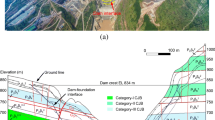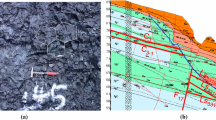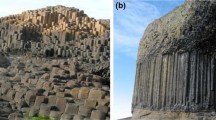Abstract
Columnar jointed basalt (CJB), characterized by a hexagonal joint network, poses a great challenge for geotechnical designs due to its time-dependent propensity to deformation and damage. In this paper, the geometrical structure and failure modes of CJB exposed on a dam foundation is presented. The study was conducted during the unloading excavation of the Baihetan dam, China, aiming to provide a more in-depth understanding of the CJB damage mechanism. A systematic field test for the columnar jointed rock mass was also carried out on the dam foundation using ultrasonic P wave measurements. It was found that the excavation damage zone of the CJB not only showed time-dependent damage both in depth and degree but also showed spatially inhomogeneous distribution of the damage degree. Sequential regression analysis further demonstrated the time-dependent behavior of the CJB. Successive observations using digital borehole cameras in the field showed that the unloading damage mechanism of the Baihetan CJB was mainly related to the time-dependent opening of the initially closed joints. Several reinforcing methods for improving the stability of the damaged CJB, including the injection of liquid cement and the installation of the prestressed rock bolts, are discussed.




















Similar content being viewed by others
References
Armand G, Leveau F, Nussbaum C, Vaissiere RDL, Noiret A (2014) Geometry and properties of the excavation-induced fractures at the Meuse/haute-Marne URL drifts. Rock Mech Rock Eng 47(1):21–41
Aydin A (2014) Upgraded ISRM suggested method for determining sound velocity by ultrasonic pulse transmission technique. Rock Mech Rock Eng 47(1):255–259
Brady BHG, Brown ET (1985) Rock mechanics for underground mining. Springer, Dordrecht
Bonilla-Sierra V, Scholtes L, Donze FV, Elmouttie MK (2015) Rock slope stability analysis using photogrammetric data and DFN–DEM modelling. Acta Geotech 10(4):497–511
Budkewitsch P, Robin PY (1994) Modelling the evolution of columnar joints. J Volcanol Geotherm Res 59(3):219–239
Bosshard SA, Mattsson HB, Hetényi G (2012) Origin of internal flow structures in columnar-jointed basalt from Hrepphólar, Iceland: I. textural and geochemical characterization. Bull Volcanol 74(7):1645–1666
Barton N, Lien R, Lunde J (1974) Engineering classification of rock masses for the design of tunnel support. Rock Mech Rock Eng 6:189–236
Chen X, Xu Z (2017) The ultrasonic P-wave velocity-stress relationship of rocks and its application. Bull Eng Geol Environ 76: 661–669
Cui J, Jiang Q, Feng XT et al (2018) Insights into statistical structural characteristics and deformation properties of columnar jointed basalts: field investigation in the Baihetan dam base, China. Bull Eng Geol Environ 77(2):775–790
El-Naqa A, Kuisi MA (2002) Engineering geological characterisation of the rock masses at Tannur dam site. South Jordan Environ Geol 42(7):817–826
Fahimifar A, Soroush H (2005) Effect of time on the stress–strain behaviour of a single rock joint. Bull Eng Geol Env 64(4):383–396
Fan QX, Zhou SX, Yang N (2015) Optimization design of foundation excavation for Xiluodu super-high arch dam in China. J Rock Mech Geotech Eng 7(2):120–135
Fang SM, Li JF, Wu SL (2011) Large six-party columnar joints of acidic volcanic rocks and its geological causes and significance in Hong Kong China. Mar Sci 35(5):89–94
Feng XT, Hao XJ, Jiang Q et al (2016) Rock cracking indices for improved tunnel support design: a case study for columnar jointed rock masses. Rock Mech Rock Eng 49(6):2115–2130
Gage JR, Wang HF, Fratt D, Turner AL (2014) In situ measurements of frock mass deformability using fiber Bragg grating strain gauges. Int J Rock Mech Min Sci 71(71):350–361
Goehring L, Lin Z, Morris SW (2006) An experimental investigation of the scaling of columnar joints. Phys Rev E 74(036115):1–13
GB 50218 (1995) Standard for engineering classification of rock mass. Ministry of Water Resources of the People’s Republic of China, Beijing
Hetenyi G, Taisne B, Fanny G et al (2012) Scales of columnar jointing in igneous rocks: field measurements and controlling factors. Bull Volcanol 74(2):457–482
Hoek E, Brown ET (1997) Practical estimates of rock mass strength. Int J Rock Mech Min Sci 34:1165–1186
Justo JL, Garcıa-Nunez JC, Vazquez-Boza M, Justo E, Durand P (2014) Design of Raft Foundations for high-rise buildings on jointed rock. Rock Mech Rock Eng 47(4):1277–1290
Jin CY, Yang CX, Fang D, Xu S (2015) Study on the failure mechanism of basalts with columnar joints in the unloading process on the basis of an experimental cavity. Rock Mech Rock Eng 48(3):1275–1288
Jiang Q, Feng XT, Hatzor YH et al (2014) Mechanical anisotropy of columnar jointed basalts: an example from the Baihetan hydropower station, China. Eng Geol 175(3):35–45
Justo JL, Justo E, Durand P et al (2006) The Foundation of a 40-storey tower in jointed basalt. Int J Rock Mech Min Sci 43(2):267–281
Kofichko AV (1996) Characteristics of deformation of the rock mass in the foundation of high concrete dams. Hydrotech Constr 30(8):445–449
Kachanov LM (1958) Time of the rupture process under creep conditions. Izv.akad. Nauk. SSSR Otd Tech Nauk: 26–31
Li JL, Wang LH, Wang XX, Wang RH, Cheng Z, Dang L (2010) Research on unloading nonlinear mechanical characteristics of jointed rock masses. J Rock Mech Geotech Eng 2(4):357–364
Li SJ, Feng XT, Wang CY, Hudson JA (2013) ISRM suggested method for rock fractures observations using a borehole digital optical Televiewer. Rock Mech Rock Eng 46(3):635–644
Li SJ, Feng XT, Li ZH et al (2011) In situ experiments on width and evolution characteristics of excavation damaged zone in deeply buried tunnels. Sci Chin S E Tech Sci 54(s1):167–174
Lin P, Zhou WY, Liu H (2015) Experimental study on cracking, reinforcement, and overall stability of the Xiaowan super-high arch dam. Rock Mech Rock Eng 48(2):819–841
Lore J, Gao H, Aydin A (2000) Viscoelastic thermal stress in cooling basalt flows. J Geophys Res 105(B10):23695–23709
Lucas G, Stephen WM (2008) Scaling of columnar joints in basalt. J Geophys Res 113(B10203):1–18
Luo D, Lin P, Li QB, Zheng D, Lin H (2015) Effect of the impounding process on the overall stability of a high arch dam: a case study of the Xiluodu dam. Chin Arab J Geosci 8(11):9023–9041
Maxwell SC, Young RP, Read RS (1998) A micro-velocity tool to assess the excavation damaged zone. Int J Rock Mech Min Sci 35:235–247
Millard A, Jobst M, Amel R, Uehara S (2009) Study of the initiation and propagation of excavation damaged zones around openings in argillaceous rock. Environ Geol 57(6):1325–1335
Maleki MR (2011) Study of the engineering geological problems of the Havasan dam, with emphasis on clay-filled joints in the right abutment. Rock Mech Rock Eng 44(6):695–710
Malan DF (2002) Simulating the time-dependent behaviour of excavations in hard rock. Rock Mech Rock Eng 35:225–254
Müller G (1998) Starch columns: analog model for basalt columns. J Geophys Res 103(B7):15239–15253
Meglis IL, Chow T, Martin CD, Young RP (2005) Assessing in situ microcrack damage using ultrasonic velocity tomography. Int J Rock Mech Min Sci 42(1):25–34
Malmgren L, Saiang D, Toyra J et al (2007) The excavation disturbed zone (EDZ) at Kiirunavaara mine, Sweden—by seismic measurements. J Appl Geophys 61:1–15
Nabil SA, Ala D (2001) Geological and geotechnical characteristics of Karameh dam site, north of the Dead Sea, Jordan. Bull Eng Geol Environ 60(4):291–299
Ozcan NT, Ulusay R, Isik NS (2013) A study on geotechnical characterization and stability of downstream slope of a tailings dam to improve its storage capacity (Turkey). Environ Earth Sci 69(9):1871–1890
Pei JL, Fei WP, Liu JF (2016) Spatial evolution and fractal characteristics of natural fractures in marbles under uniaxial compression loading based on the source location technology of acoustic emission. Environ Earth Sci 75(9):828–836
PSCC (The Professional standards compilation group of China) (2003) SL282–2003 design specification for concrete arch dams. China Water Power Press, Beijing
PSCC (The Professional standards compilation group of China) (2005) SL319–2005 design specification for concrete gravity dams. China Water Power Press, Beijing
Rodriguez RF, Nicieza CG, Gayarre FL, Herrera EA (2014) Characterization of intensely jointed rock masses by means of in situ penetration tests. Int J Rock Mech Min Sci 72:92–99
Rabtonov N (1963) Progress in applied mechanics. Macmillan, New York, pp 307–315
Sharifzadeh M, Sharifi M, Delbari SM (2010) Back analysis of an excavated slope failure in highly fractured rock mass: the case study of Kargar slope failure (Iran). Environ Earth Sci 60(1):183–192
Satıcıo O, Unver B (2015) Assessment of tunnel portal stability at jointed rock mass: a comparative case study. Comput Geotech 64:72–82
Scholtès L, Donzé F (2015) A DEM analysis of step-path failure in jointed rock slopes. C R Mecanique 343(2):155–165
Shao JF, Chauc KT, Feng XT (2006) Modeling of anisotropic damage and creep deformation in brittle rocks. Int J Rock Mech Min Sci 43(4):582–592
Schultz RA (1995) Limits on strength and deformation properties of jointed basaltic rock masses. Rock Mech Rock Eng 28(1):1–15
Shan ZG, Di SJ (2013) Loading-unloading test analysis of anisotropic columnar jointed basalts. J Zhejiang Univ Sci A 14(8):603–614
Shi AC, Tang MF, Zhou Q (2008) Research of deformation characteristics of columnar jointed basalt at Baihetan hydropower station on Jinsha river. Chin J Rock Mech Eng 27(10):2079–2086 (in Chinese)
Sakurai S (2010) Modeling strategy for jointed rock masses reinforced by rock bolts in tunneling practice. Acta Geotech 5:121–126
Saliba R, Jagla EA (2003) Analysis of columnar joint patterns from three-dimensional stress modeling. J Geophys Res 108(B10):1–7
Weinberger R, Eyal Y, Mortimer N (2010) Formation of systematic joints in metamorphic rocks due to release of residual elastic strain energy, Otago schist, New Zealand. J Struct Geol 32(3):288–305
Watters RJ, Zimbelman DR, Bowman SD, Crowley JK (2000) Rock mass strength assessment and significance to edifice stability, Mount Rainier and Mount Hood Cascade Range Volcanoes. Pure Appl Geophys 157(6–8):957–976
Wu ZR, Gu YC, Su HZ, Guo HQ (2009a) Mechanical effects of excavation rebound of arch dam bedrock and better concreting time of dam body. Sci Chin S E Tech Sci 52(2):513–517
Wu FQ, Liu JY, Tong L, Zhuang H, Yan C (2009b) A method for assessment of excavation damaged zone (EDZ) of a rock mass and its application to a dam foundation case. Eng Geol 104(3):254–262
Xiang Y, Wang L, Wu SH, Yuan H, Wang Z (2015) Seepage analysis of the fractured rock mass in the foundation of the main dam of the Xiaolangdi water control project. Environ Earth Sci 74(5):4453–4468
Xu WY, Zheng WT, Shi AC (2011) Classification and quality assessment of irregular columnar jointed basaltic rock mass for hydraulic engineering. J Hydraul Eng 42(3):262–270 (in Chinese)
Yarahmadi R, Bagherpour R, Sousa LO, Taherian SG (2015) How to determine the appropriate methods to identify the geometry of in situ rock blocks in dimension stones. Environ Earth Sci 74(9):6779–6790
Yan DX, Xu WY, Zheng WT et al (2011) Mechanical characteristics of columnar jointed rock at dam base of Baihetan hydropower station. J Cent S Univ Technol 18(6):2157–2162 (in Chinese)
Zhu WS, Chen YJ, Li SC, Yin FQ, Yu S, Li Y (2014) Rock failure and its jointed surrounding rocks: a multi-scale grid meshing method for DDARF. Tunn Undergr Space Technol 43(7):370–376
Zhang ZP, Zhang R, Xie HP, Liu J, Were P (2015) Differences in the acoustic emission characteristics of rock salt compared with granite and marble during the damage evolution process. Environ Earth Sci 73(11):6987–6999
Zhan SS, Wang TT, Huang TH (2016) Variations of hydraulic conductivity of fracture sets and fractured rock mass with test scale: case study at Heshe well site in Central Taiwan. Eng Geol 206:94–106
Zhang W, Zhao Q, Huang RQ et al (2016) Identification of structural domains considering the size effect of rock mass discontinuities. A case study of an underground excavation in Baihetan dam. China Tunn Undergr Space Technol 51:75–83
Acknowledgements
The authors gratefully acknowledge Prof. Jianrong Xu, Prof Mingfa Tang for the help in field geological investigation and test, and the financial supports from the National Key Research and Development Program (No. 2016YFC0600707), National Natural Science Foundation of China (Grant No. 51779251) and the Hubei Province outstanding youth fund (No. 2017CFA060) and the CAS Pioneer Hundred Talents Programs.
Author information
Authors and Affiliations
Corresponding author
Rights and permissions
About this article
Cite this article
Jiang, Q., Wang, B., Feng, XT. et al. In situ failure investigation and time-dependent damage test for columnar jointed basalt at the Baihetan left dam foundation. Bull Eng Geol Environ 78, 3875–3890 (2019). https://doi.org/10.1007/s10064-018-1399-y
Received:
Accepted:
Published:
Issue Date:
DOI: https://doi.org/10.1007/s10064-018-1399-y




